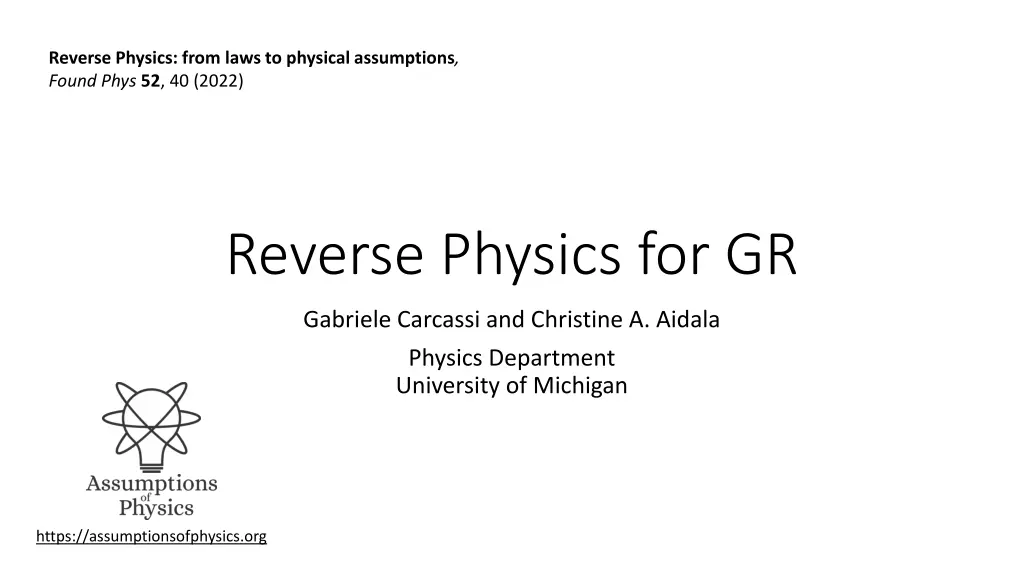
Unraveling The Physics Assumptions: Insights from Reverse Physics
Explore the intriguing concepts of Reverse Physics, Hamiltonian mechanics, and the geometry of least action in this comprehensive review of physical assumptions and laws. Dive deep into the intricate relations between states, configurations, and degrees of freedom in GR and field theory.
Uploaded on | 0 Views
Download Presentation

Please find below an Image/Link to download the presentation.
The content on the website is provided AS IS for your information and personal use only. It may not be sold, licensed, or shared on other websites without obtaining consent from the author. If you encounter any issues during the download, it is possible that the publisher has removed the file from their server.
You are allowed to download the files provided on this website for personal or commercial use, subject to the condition that they are used lawfully. All files are the property of their respective owners.
The content on the website is provided AS IS for your information and personal use only. It may not be sold, licensed, or shared on other websites without obtaining consent from the author.
E N D
Presentation Transcript
Reverse Physics: from laws to physical assumptions, Found Phys52, 40 (2022) Reverse Physics for GR Gabriele Carcassi and Christine A. Aidala Physics Department University of Michigan https://assumptionsofphysics.org
Hamiltonian mechanics det/rev + DOF independence ????= ???? ????= ???? ??= ???????= ??? ???? + ?? = ???? + ???? ?????? + ? ??2 Assumptions of Physics, Michigan Publishing (v2 2023) (?2,?2) ( ?2, ?2) 0 1 0 ?? ???= 1 (?1,?1) ( ?1, ?1) Scalar product across DOFs Area within each DOF #states = #confDOF Volume = #states Areas = #confDOF Hamiltonian is the continuous version of Recovers relativistic particle mechanics without additional assumptions https://assumptionsofphysics.org/
Geometry of principle of least action (SDOF) ?,0, ? DR ???? + 0??? ???? KE ? ? = ???? = ? ? ?????? ? = 0 ? = ? No state is lost or created as time evolves (Minus sign to match convention) Sci Rep13, 12138 (2023) The action is the line integral of the vector potential (unphysical) ? ? Variation of the action Gauge independent, physical! ? ? ? ? ?? ? = ? ? = ? ? ? Variation of the action measures the flow of states (physical). Variation = 0 flow of states tangent to the path. https://assumptionsofphysics.org/
Counting states and configurations Discrete case ? #DOF(?)= #? #conf(?)= #? #states(?)= #? ?2 ? ?1 State density Configuration density #? = Continuous case #states(?)= ? ????1 ???? #conf(?)= ?????????? (?2,?2) #DOF(?)= #? Ham Mech Correct count of configurations/states on finitely many dense (i.e. continuous) DOFs ? (?1,?1) ? Field theory DOFs themselves are dense (i.e. continuous) #DOF(?) #? https://assumptionsofphysics.org/
Conjecture: GR det/rev + DOF independence for infinitely many (dense) DOFs ? ???? = ? ?????= ????????? #conf #DOFs=? Flow of states ? ? ??? =??? Line integral of the vector potential of the flow of state density? #DOFs? ??3? = ?+ ?????? ? Flow of DOFs? Flow of configurations? We are mapping values between Cauchy surfaces, #DOFs are the points on the Cauchy surface, #conf are the possible field values at each point https://assumptionsofphysics.org/
The problem with counting on the continuum We d like: 1. Every state is a single case (i.e. ? ? 2. Finite continuous range carries finite information (i.e. ? ? < ) 3. Count is additive for disjoint sets (i.e. ? ?? = ? ??) = 1) Pick two! Discard 1 Lebesgue measure Discard 2 counting measure ? Non-orthogonal states: different states but in different contexts ? sub-additive additive Discard 3 Quantum measure Orthogonal states: different states all else equal ? ? = 2sup ? hull ? ? = 20= 1 ? ? Exponential of the maximum entropy reachable with convex combinations (statistical mixtures) of ? (reduces to counting/Liouville measure) = 21= 2 ? ?,? ? ?,? < 2 = ? ? + ? ? Quantum mechanics lower bound on #conf (entropy) on continuous DOF https://assumptionsofphysics.org/
Conjecture: quantum gravity lower bound on DOF count #conf #DOFs 1. Every point is a single DOF (i.e. ? ? 2. Finite volume carries finitely many DOFs (i.e. ? ? < ) 3. Count is additive for disjoint regions (i.e. ? ?? = ? ??) = 1) #conf=#DOFs Lower bound on this requires a lower bound on this Distant points: independent DOFs additive From QM: Lower bound on state count requires a severe revisitation of particle state space sub-additive Close points: DOFs not independent Does lower bound on DOF count require an equally severe revisitation of space-time? https://assumptionsofphysics.org/
Wrapping up Classical mechanics is exactly det/rev mapping of configurations over finitely many DOFs Conjecture: is general relativity exactly det/rev mapping of configurations over infinitely many (dense) DOFs (i.e. a field theory)? Quantum mechanics sets a lower bound on state count Entropy of pure state is zero, pure states count as one state Conjecture: is quantum gravity setting a lower bound on the DOF count? No region of space can contain less than one DOF Can we generalize the physical/geometric interpretation of the action principle to field theory and to QM? https://assumptionsofphysics.org/
